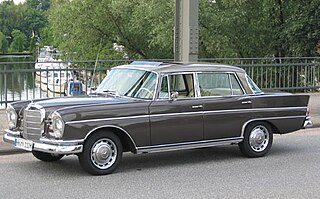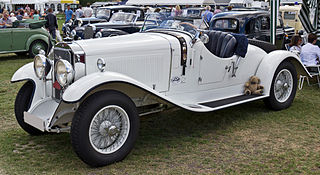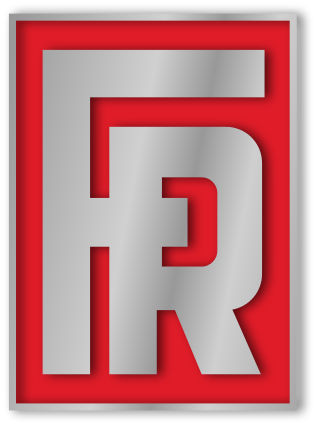
Vanden Plas is the name of coachbuilders who produced bodies for specialist and up-market automobile manufacturers. Latterly the name became a top-end luxury model designation for cars from subsidiaries of British Leyland and the Rover Group, it was last used in 2009 to denote the top-luxury version of the Jaguar XJ (X350).

Auto Union AG was an amalgamation of four German automobile manufacturers, founded in 1932 and established in 1936 in Chemnitz, Saxony. It is the immediate predecessor of Audi as it is known today.

Maybach is a German luxury car brand owned by and a part of Mercedes-Benz AG. The original company was founded in 1909 by Wilhelm Maybach and his son Karl Maybach, originally as a subsidiary of Luftschiffbau Zeppelin GmbH, and it was known as Luftfahrzeug-Motorenbau GmbH until 1999.

Pietro Frua was one of the leading Italian coachbuilders and car designers during the 1950s and 1960s.

A coachbuilder or body-maker is a person or company who manufactures bodies for passenger-carrying vehicles. Coachwork is the body of an automobile, bus, horse-drawn carriage, or railway carriage. The word "coach" was derived from the Hungarian town of Kocs. A vehicle body constructed by a coachbuilder may be called a "coachbuilt body" or "custom body".

Horch was a car manufacturer, founded in Germany by August Horch & Cie at the beginning of the 20th century.

The Mercedes-Benz W112 is a luxury automobile produced by Mercedes-Benz from 1961 to 1967. Marketed as the 300SE, it was available as a coupé, convertible, sedan, and stretched sedan (Lang), all generally similar in appearance to the corresponding Mercedes-Benz W111.
The Grose was an English automobile built between 1898 and 1901, Grose also built bodies for cars, buses, ambulances and commercial vehicles until the late 1950s.
Abbott of Farnham, E D Abbott Limited was a British coachbuilding business based in Farnham, Surrey, trading under that name from 1929. A major part of their output was under sub-contract to motor vehicle manufacturers. The business closed in 1972.

Mercedes-Benz India Pvt Ltd is a wholly owned subsidiary of the German Mercedes-Benz Group founded in 1994, with headquarters in Pune, Maharashtra, India.
The Kühlstein Wagenbau in Berlin-Charlottenburg was a coachbuilding company that produced electric cars from 1898 to 1902. Some were vehicles of in-house design, others were Jeantaud cabs built under licence. The firm also built tractor units to replace horses for use with horse-drawn carriages. Later models were also known as Kühlstein-Vollmer. Production of these vehicles was absorbed by the Neue Automobil Gesellschaft (NAG) in 1902. Kühlstein continued manufacturing coachworks, e.g. for Horch cars.

Carrozzeria Castagna is an Italian coachbuilding company based in Milan, Italy.

The Auto Union Grand Prix racing cars types A to D were developed and built by a specialist racing department of Auto Union's Horch works in Zwickau, Germany, between 1933 and 1939, after the company bought a design by Dr. Ferdinand Porsche in 1933. The Auto Union type B streamlined body was designed by Paul Jaray.

The Steyr 120 Super, Steyr 125 Super and Steyr 220 were a series of medium-sized cars built by the Austrian firm Steyr-Daimler-Puch from 1935 to 1941. The moderately streamlined body was designed by technical director Karl Jenschke (1899-1969) and was manufactured by Gläser-Karosserie GmbH in Dresden. The design had a close resemblance to the smaller Steyr 100.

Saoutchik was a French coachbuilding company founded in 1906 and based in Neuilly-sur-Seine near Paris. The company was one of the best-known coachbuilders in France in the 1920s and 1930s and, together with Figoni et Falaschi and Franay, is considered one of the most important representatives of the “Baroque” style in French coachwork in the 1930s and 1940s.

The Mercedes-Benz W08 was a large luxury car produced by Daimler-Benz. It was introduced in Autumn 1928, as Mercedes-Benz's first eight-cylinder passenger car. Also known by various “type numbers”, it remained in production with various modifications and upgrades until the later summer of 1939, the longest lived Mercedes-Benz model of the 1920s and 1930s.

The Carlton Carriage Company was a highly respected London coachbuilder that provided bespoke coachwork for some of the finest car makers of the 1920s and 1930s. They are best known for their drophead coupes which are archetypal designs of the British Jazz Era.

Karosserie Friedrich Rometsch, a German metallurgical-coachbuilding company based in Berlin-Halensee, manufactured, modified, and repaired coaches, trailers, bodies and chassis.

Karosseriebau Autenrieth was a coachbuilding company in Darmstadt, Germany between the years 1921 to 1964.

The Horch 853 Voll & Ruhrbeck Sport Cabriolet is a cabriolet automobile produced by German auto manufacturer Horch.






















